2005 Hyundai H-1 (Grand Starex) air condition
[x] Cancel search: air conditionPage 122 of 205

4
CORROSION PREVENTION AND APPEARANCE CARE
21
4
IN CASE OF EMERGENCY
21BLEEDING THE FUEL SYSTEM
CAUTION:
If overheating should occur when towing, (temperature gauge reads near red zone), taking the followingaction may reduce or eliminate the problem.
1. Turn off the air conditioner.
2. Reduce highway speed.
3. Select a lower gear when going uphill.
4. While in stop and go traffic, place
the gear selection in park or neu-tral and idle the engine at a higher speed.
! E090A01P-GAT (Diesel Motor) The fuel system should be bled to remove air as described in the illustra- tion if the fuel supply is exhaustedduring travel, when the fuel filter is replaced, or if the vehicle is not used for a long time.
1. Loosen the air plug at the top of the
fuel filter. E090A01P
13.Avoid holding the brake pedal down
too long or too frequently. This could cause the brakes to overheat, re- sulting in reduced braking efficiency.
14.When going down a hill, shift into a
lower gear and use the engine brak-ing effect. When ascending a long grade, downshift the transmissionto a lower gear and reduce speed to reduce chances of engine over- loading and/or overheating.
15.If you have to stop while going uphill, do not hold the vehicle inplace by pressing on the accelera-tor. This can cause the automatic transmission to overheat. Use the parking brake or footbrake.
NOTE: When towing, check transmission fluid more frequently.
Page 126 of 205
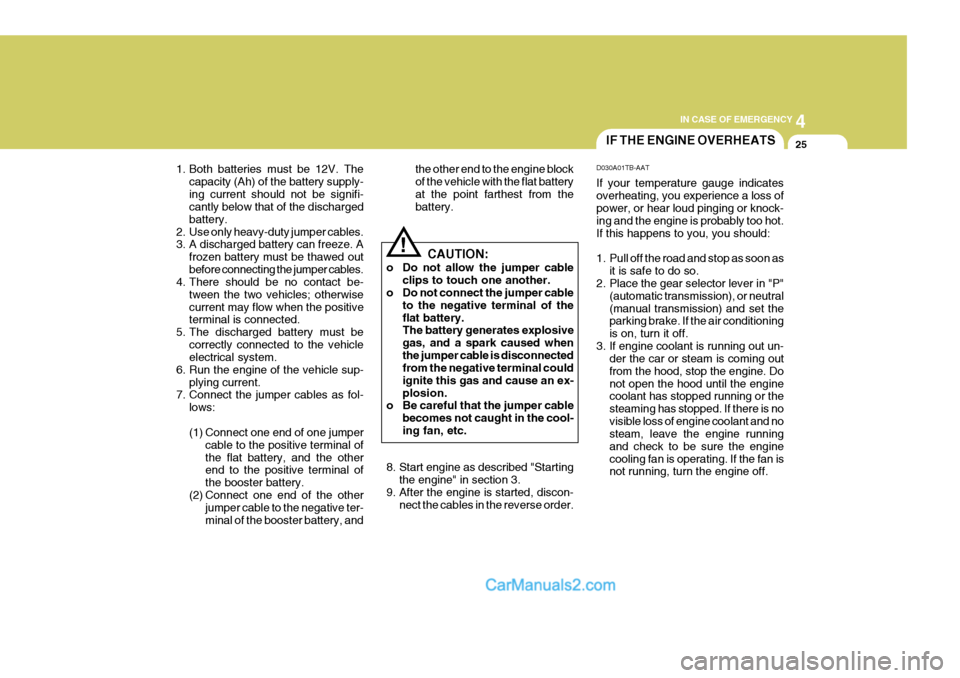
4
CORROSION PREVENTION AND APPEARANCE CARE
25
4
IN CASE OF EMERGENCY
25IF THE ENGINE OVERHEATS
CAUTION:
o Do not allow the jumper cable clips to touch one another.
o Do not connect the jumper cable
to the negative terminal of the flat battery. The battery generates explosive gas, and a spark caused whenthe jumper cable is disconnected from the negative terminal could ignite this gas and cause an ex-plosion.
o Be careful that the jumper cable
becomes not caught in the cool-ing fan, etc.
! D030A01TB-AAT If your temperature gauge indicates overheating, you experience a loss of power, or hear loud pinging or knock- ing and the engine is probably too hot.If this happens to you, you should:
1. Pull off the road and stop as soon as
it is safe to do so.
2. Place the gear selector lever in "P"
(automatic transmission), or neutral (manual transmission) and set the parking brake. If the air conditioning is on, turn it off.
3. If engine coolant is running out un- der the car or steam is coming outfrom the hood, stop the engine. Donot open the hood until the engine coolant has stopped running or the steaming has stopped. If there is novisible loss of engine coolant and no steam, leave the engine running and check to be sure the enginecooling fan is operating. If the fan is not running, turn the engine off.
the other end to the engine block of the vehicle with the flat batteryat the point farthest from the battery.
8. Start engine as described "Starting the engine" in section 3.
9. After the engine is started, discon- nect the cables in the reverse order.
1. Both batteries must be 12V. The
capacity (Ah) of the battery supply- ing current should not be signifi- cantly below that of the discharged battery.
2. Use only heavy-duty jumper cables.
3. A discharged battery can freeze. A
frozen battery must be thawed out before connecting the jumper cables.
4. There should be no contact be-
tween the two vehicles; otherwisecurrent may flow when the positive terminal is connected.
5. The discharged battery must be correctly connected to the vehicleelectrical system.
6. Run the engine of the vehicle sup- plying current.
7. Connect the jumper cables as fol-
lows:
(1) Connect one end of one jumper cable to the positive terminal of the flat battery, and the other end to the positive terminal of the booster battery.
(2) Connect one end of the other jumper cable to the negative ter-minal of the booster battery, and
Page 127 of 205
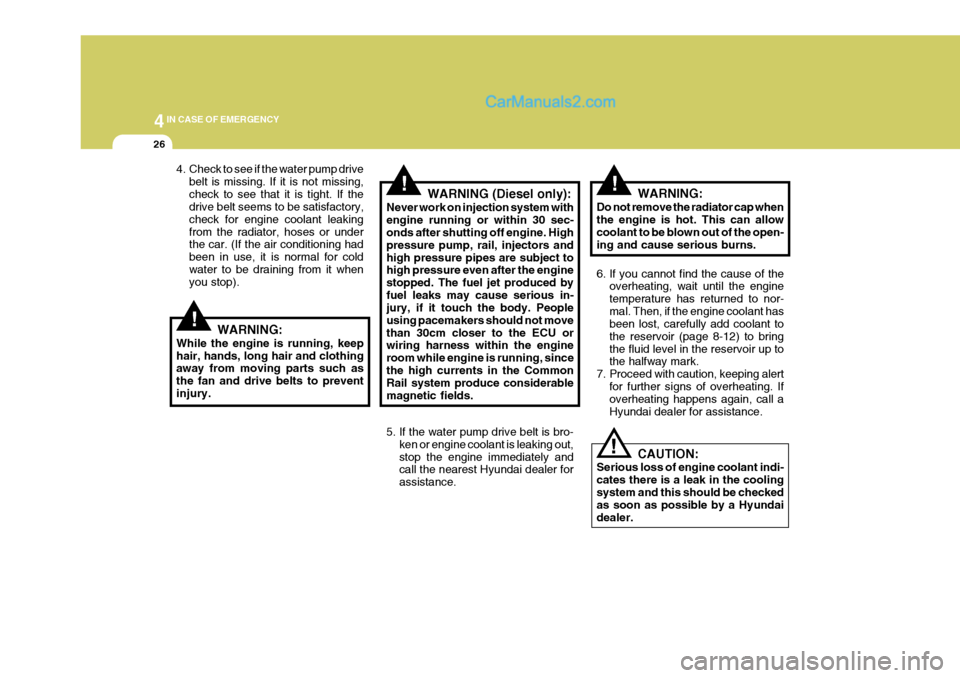
44IN CASE OF EMERGENCY
26
4. Check to see if the water pump drivebelt is missing. If it is not missing, check to see that it is tight. If the drive belt seems to be satisfactory, check for engine coolant leakingfrom the radiator, hoses or under the car. (If the air conditioning had been in use, it is normal for coldwater to be draining from it when you stop).
!WARNING:
While the engine is running, keep hair, hands, long hair and clothing away from moving parts such as the fan and drive belts to preventinjury.
!WARNING (Diesel only):
Never work on injection system with engine running or within 30 sec- onds after shutting off engine. High pressure pump, rail, injectors andhigh pressure pipes are subject to high pressure even after the engine stopped. The fuel jet produced byfuel leaks may cause serious in- jury, if it touch the body. People using pacemakers should not movethan 30cm closer to the ECU or wiring harness within the engine room while engine is running, sincethe high currents in the Common Rail system produce considerable magnetic fields.
5. If the water pump drive belt is bro- ken or engine coolant is leaking out, stop the engine immediately and call the nearest Hyundai dealer for assistance.!WARNING:
Do not remove the radiator cap when the engine is hot. This can allow coolant to be blown out of the open- ing and cause serious burns.
6. If you cannot find the cause of the overheating, wait until the engine temperature has returned to nor-mal. Then, if the engine coolant has been lost, carefully add coolant to the reservoir (page 8-12) to bringthe fluid level in the reservoir up to the halfway mark.
7. Proceed with caution, keeping alert for further signs of overheating. Ifoverheating happens again, call a Hyundai dealer for assistance.
CAUTION:
Serious loss of engine coolant indi-cates there is a leak in the coolingsystem and this should be checked as soon as possible by a Hyundai dealer.
!
Page 150 of 205
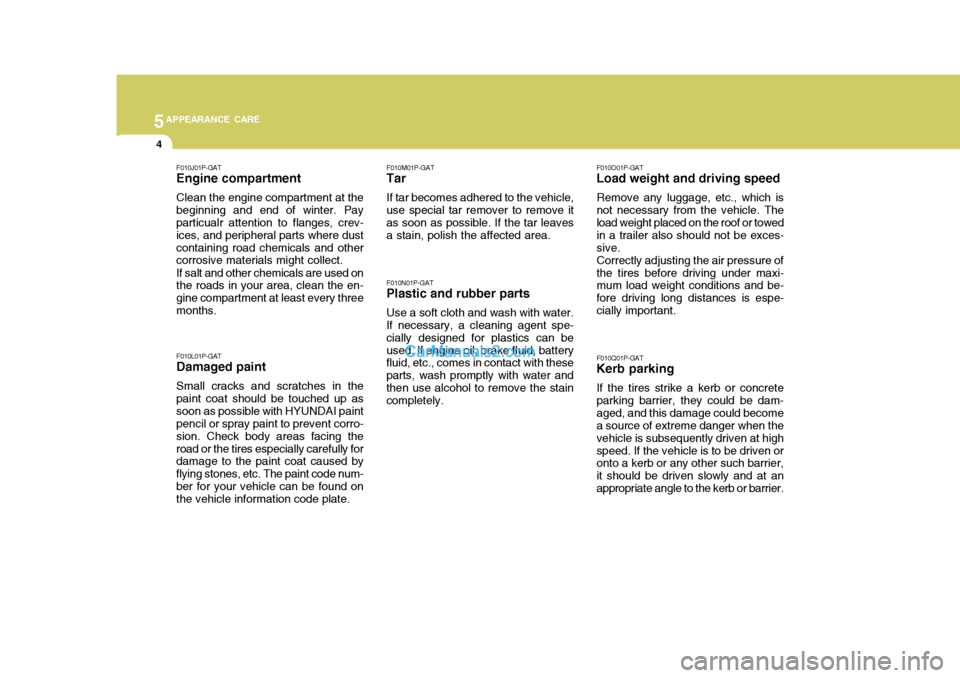
5APPEARANCE CARE
4
F010L01P-GAT Damaged paint Small cracks and scratches in the paint coat should be touched up assoon as possible with HYUNDAI paint pencil or spray paint to prevent corro- sion. Check body areas facing theroad or the tires especially carefully for damage to the paint coat caused by flying stones, etc. The paint code num-ber for your vehicle can be found on the vehicle information code plate. F010M01P-GAT
Tar
If tar becomes adhered to the vehicle, use special tar remover to remove it as soon as possible. If the tar leaves a stain, polish the affected area. F010N01P-GAT
Plastic and rubber parts
Use a soft cloth and wash with water.
If necessary, a cleaning agent spe- cially designed for plastics can beused. If engine oil, brake fluid, battery fluid, etc., comes in contact with these parts, wash promptly with water andthen use alcohol to remove the stain completely. F010O01P-GAT
Load weight and driving speed
Remove any luggage, etc., which is not necessary from the vehicle. The load weight placed on the roof or towed in a trailer also should not be exces-sive.Correctly adjusting the air pressure ofthe tires before driving under maxi- mum load weight conditions and be- fore driving long distances is espe-cially important. F010Q01P-GAT
Kerb parking
If the tires strike a kerb or concrete parking barrier, they could be dam-aged, and this damage could become a source of extreme danger when the vehicle is subsequently driven at highspeed. If the vehicle is to be driven or onto a kerb or any other such barrier, it should be driven slowly and at anappropriate angle to the kerb or barrier.
F010J01P-GAT Engine compartment Clean the engine compartment at the beginning and end of winter. Pay particualr attention to flanges, crev- ices, and peripheral parts where dustcontaining road chemicals and other corrosive materials might collect. If salt and other chemicals are used on the roads in your area, clean the en- gine compartment at least every threemonths.
Page 151 of 205
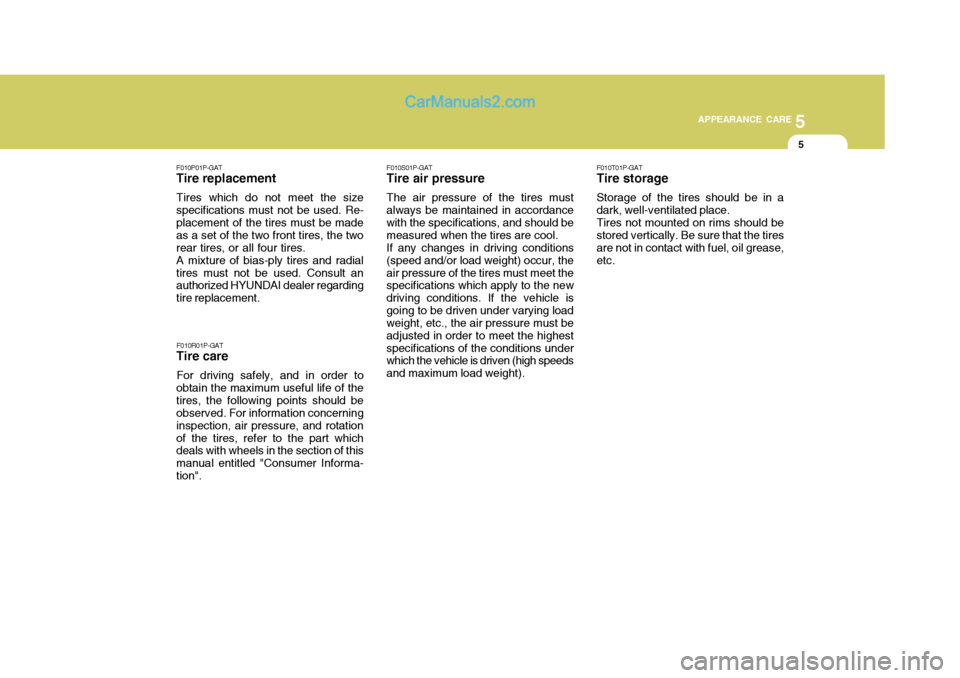
5
APPEARANCE CARE
5
F010P01P-GAT
Tire replacement
Tires which do not meet the size specifications must not be used. Re- placement of the tires must be made as a set of the two front tires, the tworear tires, or all four tires.A mixture of bias-ply tires and radialtires must not be used. Consult an authorized HYUNDAI dealer regarding tire replacement.
F010R01P-GAT
Tire care
For driving safely, and in order to
obtain the maximum useful life of thetires, the following points should be observed. For information concerning inspection, air pressure, and rotationof the tires, refer to the part which deals with wheels in the section of this manual entitled "Consumer Informa-tion". F010S01P-GAT
Tire air pressure
The air pressure of the tires mustalways be maintained in accordance with the specifications, and should be measured when the tires are cool.If any changes in driving conditions(speed and/or load weight) occur, theair pressure of the tires must meet the specifications which apply to the new driving conditions. If the vehicle isgoing to be driven under varying load weight, etc., the air pressure must be adjusted in order to meet the highestspecifications of the conditions under which the vehicle is driven (high speeds and maximum load weight). F010T01P-GAT Tire storage Storage of the tires should be in a dark, well-ventilated place.Tires not mounted on rims should bestored vertically. Be sure that the tires are not in contact with fuel, oil grease, etc.
Page 157 of 205
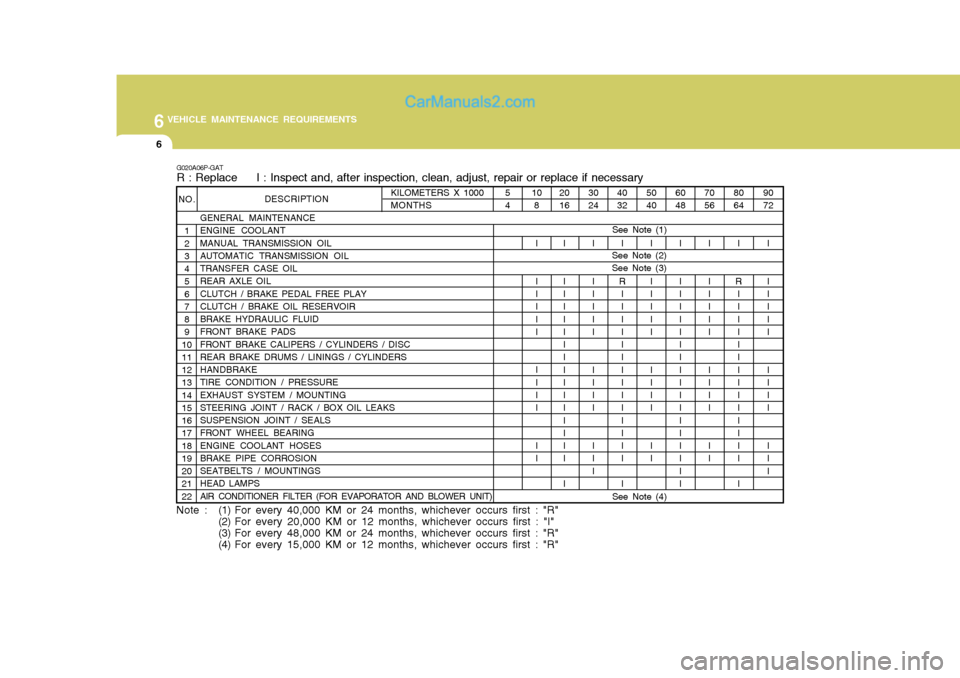
6VEHICLE MAINTENANCE REQUIREMENTS
6
50 40I I I I I I I I I I I I
KILOMETERS X 1000MONTHS
NO.
1 2 3 4 5 6 7 8 9
1011 12 13 14 15 16 17 18 19 20 21 22 DESCRIPTION
GENERAL MAINTENANCE ENGINE COOLANT MANUAL TRANSMISSION OIL AUTOMATIC TRANSMISSION OIL TRANSFER CASE OIL REAR AXLE OIL CLUTCH / BRAKE PEDAL FREE PLAY CLUTCH / BRAKE OIL RESERVOIR BRAKE HYDRAULIC FLUID FRONT BRAKE PADS FRONT BRAKE CALIPERS / CYLINDERS / DISC REAR BRAKE DRUMS / LININGS / CYLINDERS HANDBRAKE TIRE CONDITION / PRESSURE EXHAUST SYSTEM / MOUNTING STEERING JOINT / RACK / BOX OIL LEAKS SUSPENSION JOINT / SEALS FRONT WHEEL BEARING ENGINE COOLANT HOSES BRAKE PIPE CORROSION SEATBELTS / MOUNTINGS HEAD LAMPS AIR CONDITIONER FILTER (FOR EVAPORATOR AND BLOWER UNIT)
G020A06P-GAT R : Replace I : Inspect and, after inspection, clean, adjust, repair or replace if necessary
80 64
I
R II I I I I I I I I I I I I I 90 72
I I I I I I I I I I I I I
70 56
I I I I I I I I I I I I
6048
I I I I I I I I I I I I I I I I I I
4032
I
R II I I I I I I I I I I I I I
30 24
I I I I I I I I I I I I I
20 16
I I I I I I I I I I I I I I I I I108
I I I I I I I I I I I I
5 4
See Note (1)
Note : (1) For every 40,000 KM or 24 months, whichever occurs first : "R" (2) For every 20,000 KM or 12 months, whichever occurs first : "I"
(3) For every 48,000 KM or 24 months, whichever occurs first : "R"
(4) For every 15,000 KM or 12 months, whichever occurs first : "R"
See Note (4)
See Note (2) See Note (3)
Page 161 of 205
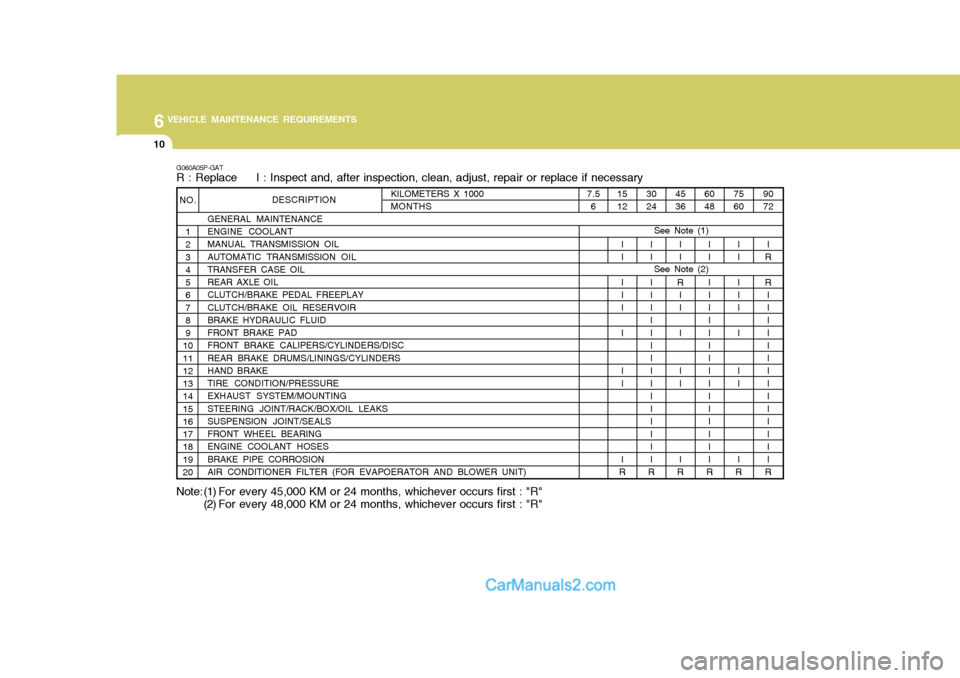
6VEHICLE MAINTENANCE REQUIREMENTS
10
45 36II
R II I I I I
R
15 12
II I I I I I I I
R
G060A05P-GAT R : Replace I : Inspect and, after inspection, clean, adjust, repair or replace if necessary
See Note (2)
KILOMETERS X 1000 MONTHS
NO.
1 2 3 4 5 6 7 8 9
1011 12 13 14 15 16 17 18 19 20 DESCRIPTION
GENERAL MAINTENANCE ENGINE COOLANT MANUAL TRANSMISSION OIL AUTOMATIC TRANSMISSION OIL TRANSFER CASE OIL REAR AXLE OIL CLUTCH/BRAKE PEDAL FREEPLAY CLUTCH/BRAKE OIL RESERVOIR BRAKE HYDRAULIC FLUID FRONT BRAKE PAD FRONT BRAKE CALIPERS/CYLINDERS/DISC REAR BRAKE DRUMS/LININGS/CYLINDERS HAND BRAKE TIRE CONDITION/PRESSURE EXHAUST SYSTEM/MOUNTING STEERING JOINT/RACK/BOX/OIL LEAKS SUSPENSION JOINT/SEALS FRONT WHEEL BEARING ENGINE COOLANT HOSES BRAKE PIPE CORROSION AIR CONDITIONER FILTER (FOR EVAPOERATOR AND BLOWER UNIT)
75 60
II I I I I I I I
R 90 72
I
R R I I I I I I I I I I I I I I
R
6048
II I I I I I I I I I I I I I I I
R
3024
II I I I I I I I I I I I I I I I
R
7.5
6
See Note (1)
Note: (1) For every 45,000 KM or 24 months, whichever occurs first : "R"
(2) For every 48,000 KM or 24 months, whichever occurs first : "R"
Page 162 of 205
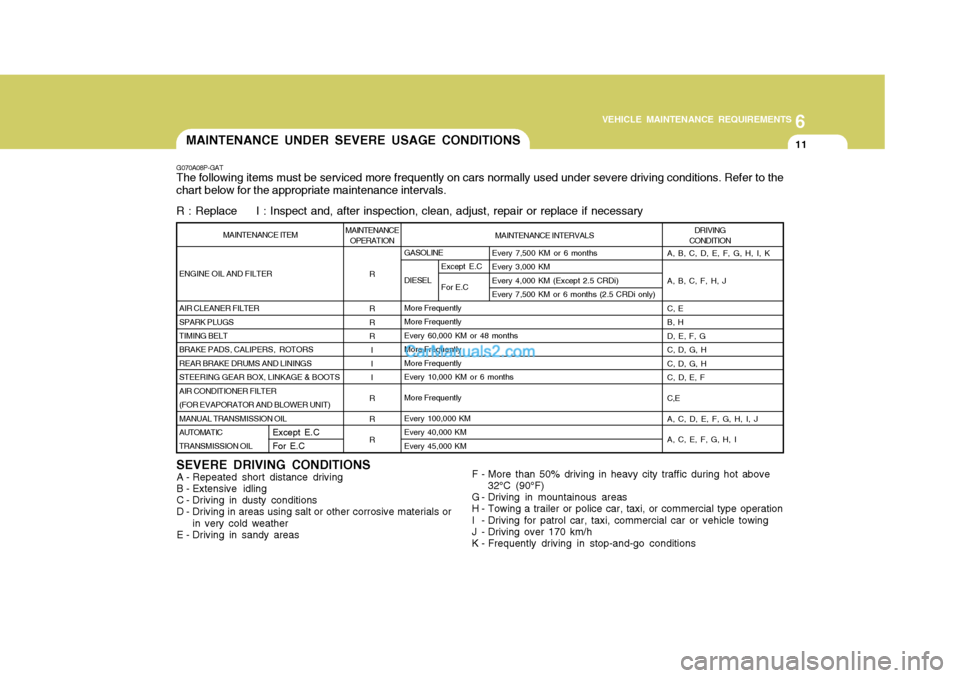
6
VEHICLE MAINTENANCE REQUIREMENTS
11
GASOLINE DIESELMore Frequently More Frequently Every 60,000 KM or 48 monthsMore FrequentlyMore FrequentlyEvery 10,000 KM or 6 months More Frequently Every 100,000 KM Every 40,000 KMEvery 45,000 KM Every 7,500 KM or 6 monthsEvery 3,000 KMEvery 4,000 KM (Except 2.5 CRDi)Every 7,500 KM or 6 months (2.5 CRDi only)
ENGINE OIL AND FILTER AIR CLEANER FILTER SPARK PLUGSTIMING BELT BRAKE PADS, CALIPERS, ROTORS REAR BRAKE DRUMS AND LININGSSTEERING GEAR BOX, LINKAGE & BOOTSAIR CONDITIONER FILTER(FOR EVAPORATOR AND BLOWER UNIT)MANUAL TRANSMISSION OIL AUTOMATIC TRANSMISSION OIL
G070A08P-GAT The following items must be serviced more frequently on cars normally used under severe driving conditions. Refer to the chart below for the appropriate maintenance intervals. R : Replace I : Inspect and, after inspection, clean, adjust, repair or replace if necessary
R R RR
I I I
R R R
SEVERE DRIVING CONDITIONS A - Repeated short distance driving
B - Extensive idling
C - Driving in dusty conditions
D - Driving in areas using salt or other corrosive materials or
in very cold weather
E - Driving in sandy areas
A, B, C, D, E, F, G, H, I, K A, B, C, F, H, J C, E B, HD, E, F, GC, D, G, HC, D, G, H C, D, E, F C,EA, C, D, E, F, G, H, I, J A, C, E, F, G, H, I DRIVING
CONDITION
MAINTENANCE INTERVALS
MAINTENANCE
OPERATION
MAINTENANCE ITEM
F - More than 50% driving in heavy city traffic during hot above32°C (90°F)
G - Driving in mountainous areas
H - Towing a trailer or police car, taxi, or commercial type operation
I - Driving for patrol car, taxi, commercial car or vehicle towing
J - Driving over 170 km/h
K - Frequently driving in stop-and-go conditions
MAINTENANCE UNDER SEVERE USAGE CONDITIONS
Except E.C For E.C
Except E.C For E.C